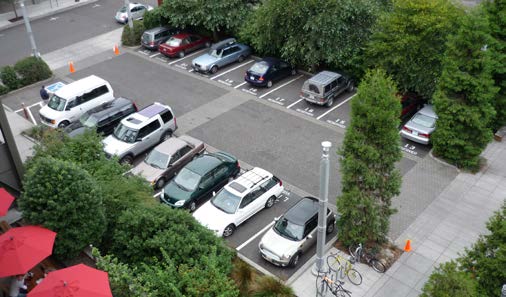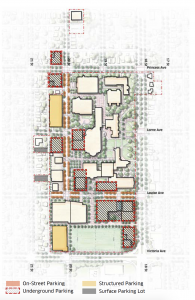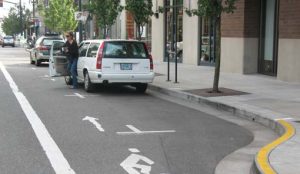Parking

Over the 30-year time horizon of the Campus Master Plan, surface parking on campus, and particularly along 20th Street will be phased out in order to accommodate future growth. As the Campus evolves, surface parking facilities will shift to below-grade parking in new buildings or to structured parking facilities that are part of the Campus’ development.
This is to make room for new buildings and open spaces. The only surface parking lots to remain on the Campus would be the two small lots along 21st Street. All other surface parking areas are for the purpose of accommodating pedestrian pick-up or drop-off in designated areas, and to provide handicapped-accessible parking close to buildings.
In addition, the Campus Master Plan’s sustainable approach to movement is intended to shift the modal split away from vehicular use, and thus reduce the demand for parking. The Plan anticipates that the proportional need for parking will decline with time as the modal split increases. However, the Plan also recognizes that there is a significant rural-based student body that will continue to drive out of necessity, and requires parking.
The parking strategy as such includes on-street parking on the internal campus streets, two dedicated mixed-use structured parking sites, located in the north and one south areas of the campus, and a minimum of two levels of below-grade parking in all new buildings.
Policies:
- Structured parking facilities should not be a stand alone use for any building development. Parking structures should be fronted by other uses that provide active use and animation at grade such as services and amenities.
- The design of structured parking facilities should be of the highest architectural design and material quality, in keeping with the quality of design recommended in the Built Form Framework for new campus buildings. Design innovation should be considered that contributes to the Campus’ identity.
- Structured parking facilities need to be open and transparent, allowing views into and through the building, at ground level and within the building.
- Structured parking facilities must be well-integrated with the public realm, providing a friendly “human scale” presence on the adjacent public realm and contribute to a pedestrian-focused environment.
- On-street parking is provided on the internal campus street as short-term, timed parking spaces.
- Two to three short-term, timed handicapped parking spaces are provided in the Clark Hall plaza.
- On-Street parking should be provided along the entire length of Louise Avenue with the exception of the Lower Plaza and pedestrian crossing areas, and the dedicated Healthy Living Centre drop-off and pick-up zone.
- On-Street parking must be provided along the entire length of 20th Street with the exception of the East-West Plaza and pedestrian crossing areas, and the dedicated Centennial Auditorium drop-off and pickup zone.
- On-street parking is to be provided in the form of parking lay-bys with parking bump-outs at the intersections or at identified pedestrian crossing zones.
- The west surface parking lots integrated within the residential block should be enhanced with landscaping and sustainable surface paving treatments so that they are attractive parking areas within the neighbourhood. Landscaping along the parking lot perimeter should be used to create a green screen between adjacent residential buildings.


